Dreaming of photographing the Northern Lights? There is no better spot for taking the most spectacular Aurora Borealis shots than Iceland. Last October, I spent 21 days chasing the Aurora in the land of ice. When I arrived in Iceland, I had no idea how to track down an Aurora. I thought they happened every night. I assumed you just popped your head out of your hotel window and kaboom, Lady Aurora comes by with a free show. Not so much. You can be lucky, but often you have to work a little bit harder to get that magical Northern Lights shot.
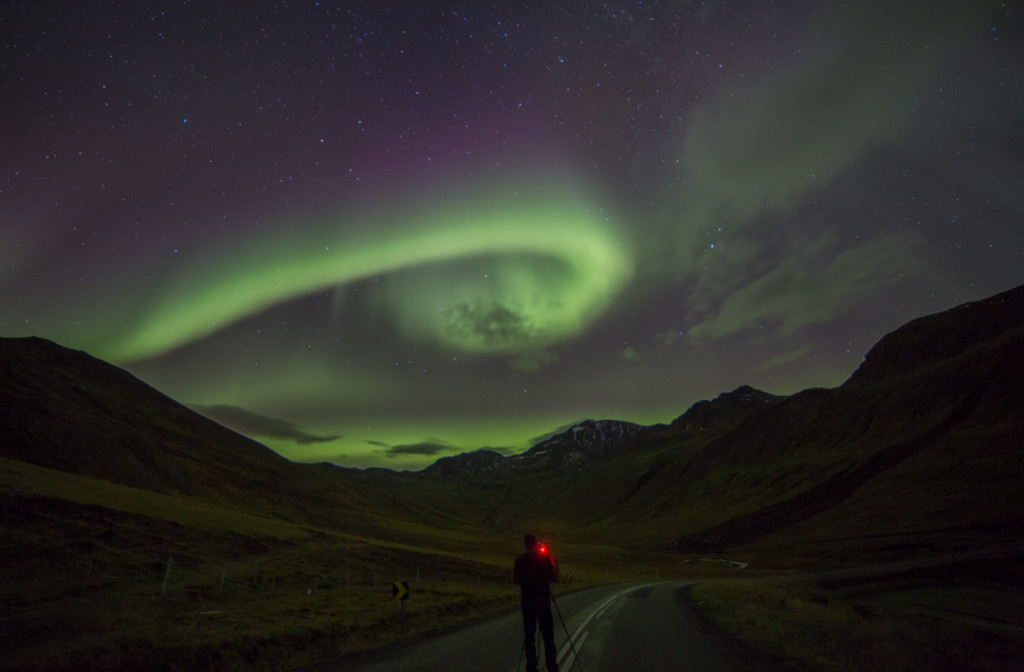
Photographing the Aurora in the Northern-most tip of the Troll Peninsula. f/2.8, 15s, ISO 1600.
How to find an Aurora in Iceland:
In order to get the odds in your favour, here are some tips to finding the Northern Lights in Iceland. As always, bring some snacks ;)
1. Visit Iceland at the right time of year
Your best chance at viewing the Northern Lights in Iceland is anytime from September to mid April. It needs to be completely dark to view an Aurora and after April, there are fewer dark hours for viewing. By July, it is light almost all the time. I went in early October which ended up being the perfect time to go. The weather was very wet and windy though and I did experience a few very cloudy days which obscured the Aurora. If you are serious about capturing the Aurora, you will probably need more than a 4 day stopover. Out of the 21 days in Iceland, I saw 8 good Auroras, 3 amazing ones, and 1 complete whammy.
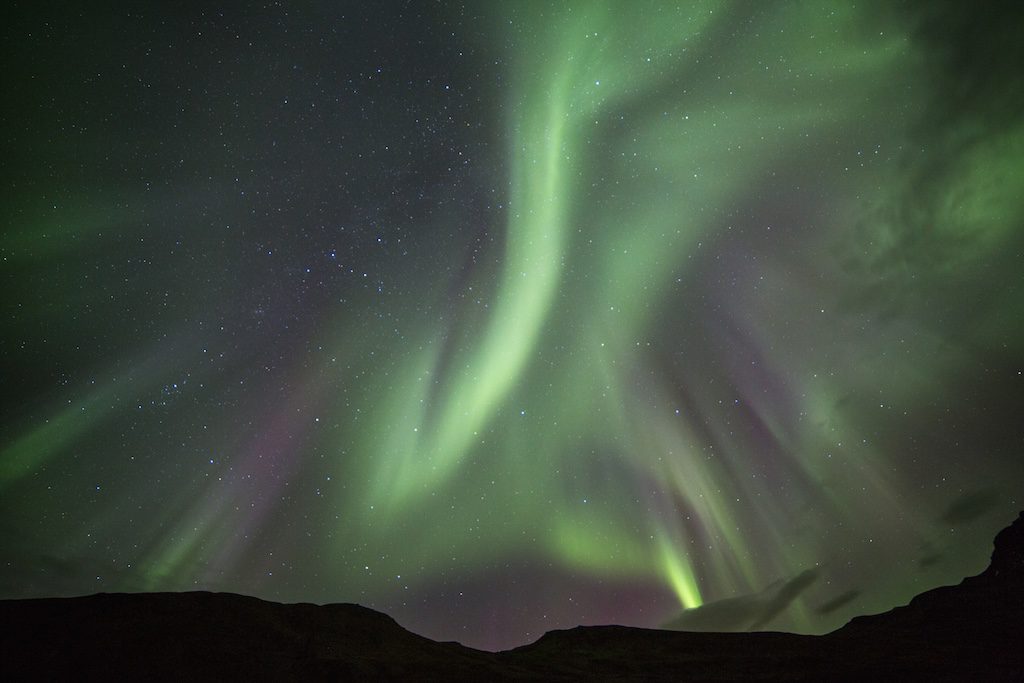
2. Check the Aurora forecast
The Aurora Borealis occurs when particles from the sun enter Earth’s atmosphere and collide with gas atoms. The most important thing to know about getting great aurora photographs is the kp index. The index is a scale of geomagnetic activity with numbers between 0 – 9 with 0 being no Aurora and 9 being a knock your socks off Aurora. Iceland is very far North, so Auroras as low as a 2 or 3kp can be seen with the naked eye. At this kp, the Aurora will look more like a blurry green haze than the defined green streaks that you are used to seeing in photographs. A 5 or greater is an amazing show and you will start to see more colours in the sky – magentas, reds, pinks and blues. I was blessed with seeing a 9 and it was so vivid it was almost blinding. I generally didn’t go out shooting unless the kp was 4 or greater. I found that my photographs weren’t that great with a 3 or lower. That being said, the sky can shift very quickly, so the night might start out as a 2 and end as a 5. It’s all a matter of how much sleep you want to get.
If you are looking to plan for a night of Aurora viewing during Iceland trip, Vedur.is offers kp predictions up to 5 days ahead. I also used an Aurora Forecast app on my iPhone to predict the aurora activity level. If you are feeling lazy, most hotels monitor the kp index and offer wake up calls in the middle of the night if the Aurora goes above a 3.
3. Find clear skies
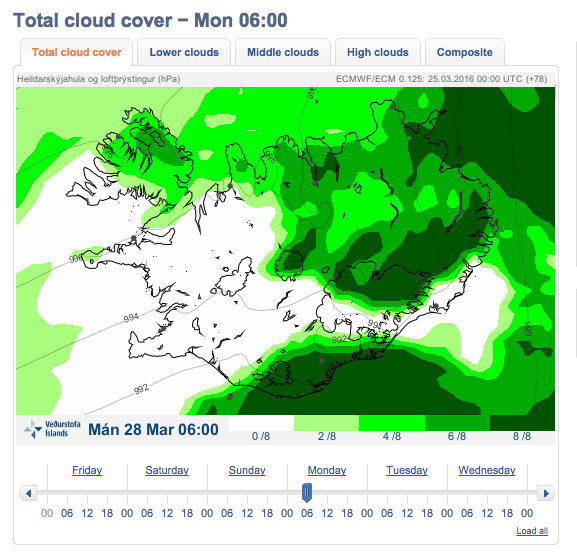
In order to see the Northern lights, you want little to no cloud cover in the sky. Some cloud can look really cool (see the below image from Hellnar). The easiest way to find out where the best location is with no clouds to go to this link on Iceland Met Office website. You should see an image like the one above. The white areas are clear with no cover. The darker the green the worse the cloud cover and in those conditions you will not see the aurora. The Vedur.is website is great because you can use it to plan ahead. When I was in Iceland, I chased the clear skies around the island. If I knew there where going to be clear skies in an area, I would book new hotels and change all my travel plans to go to that area. If you rent a camper van, this is even easier because you don’t have to cancel and rebook hotels. If you aren’t as hardcore, a little middle or high clouds is ok. You will still be able to see the Aurora, but your photos will have some clouds in them which can turn out pretty cool.

Northern Lights snake above Godafoss waterfall, 14mm, 15s at f/2.8, ISO 1600.
4. Get away from all light pollution
This is pretty easy in Iceland, but if you are staying in Reykjavik or Akureyri or a bigger town with street lights, you might want to head out into the wilderness a little to escape the lights. I drove around a lot scouting good spots without street lights, but often found myself driving around like crazy as the Aurora started to show because menacing house lights popped up at the last minute. Most of the time you just have to fly by the seat of your pants when you are traveling to a new location, but if you can keep your eyes peeled and always be on the lookout of cool spots, it certainly helps. Trust me, when you see those green streaks in the sky, you will feel such awe, you will want to shoot right away and not drive around in a panic.

Siglufjörður, North Iceland, 14mm. f/2.8 at 20s, ISO 1250.
Basic photography tips for Northern Lights
I cover this more in depth in THIS post, but since you are here, you are probably wanting a few tips, and who am I to deny you? So quickly…
1. Use a Wide angle lens. The 14mm, 15mm or 16-35mm work best.
2. Focus to infinity using Manual focus. This symbol –> ∞. I find that each of my lenses is slightly different as to the exact point. Some I set to slightly before infinity others on. Play with this and over time you will find the money zone for your lens.
3. Set your Aperture to wide open. f/2.8 if you can. Let in as much light as you can!
4. Set your Shutter speed from 5-30s. This is the setting you will be constantly changing depending on how bright the aurora is. I had to change the shutter speed constantly. With weaker Auroras (kp 2-3), you will most likely need a 30s exposure to see the lights (see the photo below from Jokulsarlon). For bada bing Auroras, (aside: does anyone else miss Tony Soprano?), you might only need a 5-10s exposure.
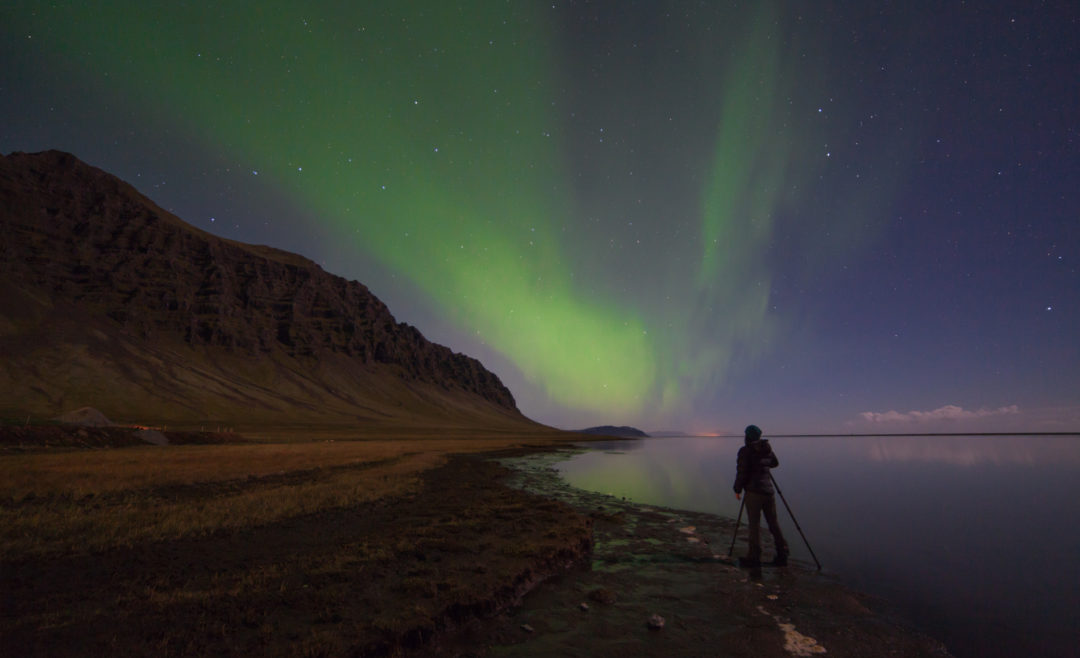
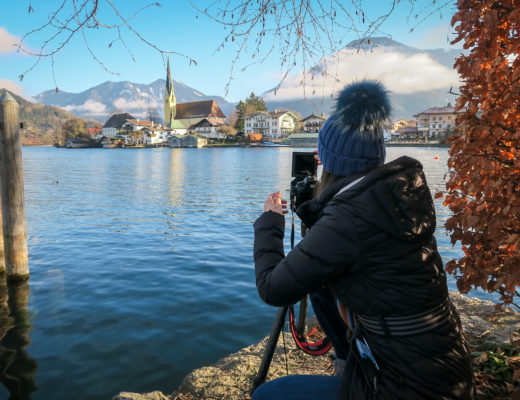
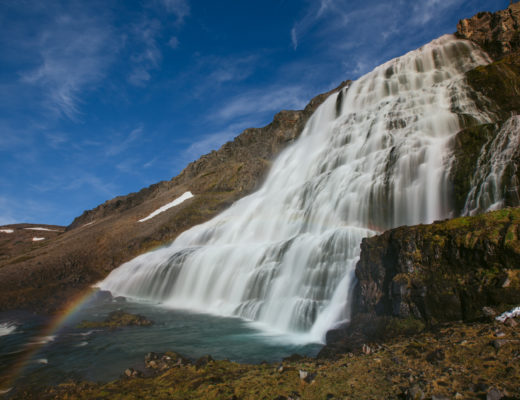
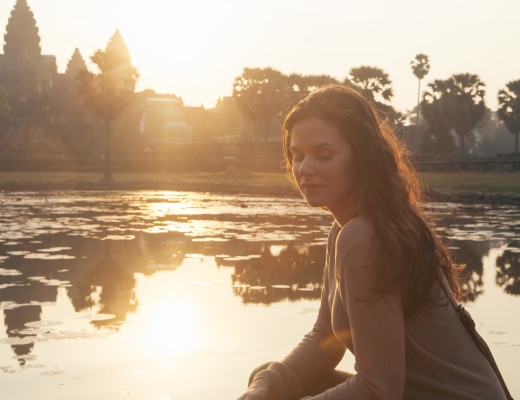
Edward Iglesias
October 20, 2016 at 11:48 AMThanks Lisa. As usual this provides some very good and practical advice. I thought it was just go to the official aurora viewing station at the scheduled time and bring your tripod.
Mostly Lisa
October 20, 2016 at 12:09 PMha! if only… the photographs make it look easy, but you can chase an aurora all the way around the island! I changed my hotel plans 3 times to accommodate the cloudy skies.
Jorge Gomez
October 21, 2016 at 6:49 AMVery good info, Thanks for sharing!
Mostly Lisa
October 21, 2016 at 6:51 AMYou’re welcome! Hope you get to photograph some amazing lights this year :)
Richie Johns
October 23, 2016 at 1:14 PMInteresting reading Lisa, and some practical info on capturing the aurora I’ve been three times now, traveling around in a rented motor home. Saw the lights twice on each occasion. One evening the show started very early, just as the sun was setting, much to our amazement.
David Dempster
November 8, 2016 at 12:42 PMWe are staying in Reykjavic and are hoping to photograph the lights. Will we need to go outside the city to view them?.
Mostly Lisa
November 21, 2016 at 6:46 AMYou will probably be able to see them depending on how bright they are. Would be better to drive a little bit out of town for pictures. I have seen some good Picts of the lights behind the sun voyager sculpture:
Tim White
January 4, 2017 at 12:55 PMI am looking at Iceland for October and somewhere between 18 and 21 days by myself in a camper van. Having lived in Alaska 30 years I have seen amazing Auroras, but just got into photography. Still investigating and trying to plan where to go and what to see besides Auroras. Would love to photograph puffins, but they will be gone when I get there, perhaps a future trip. Thank you for the information. As I research Iceland, anyone who can guide me into interesting areas or interesting photos I truly appreciate.
Mostly Lisa
January 4, 2017 at 1:16 PMHi! May/June is the best time for puffins. In late September and early October, you will find amazing autumn colours. I recommend Hraunfossar and the Snæfellsnes peninsula. In 21 days you can circumnavigate the entire island (minus the West Fjords). Just follow the ring road…
Ahmed
June 13, 2017 at 10:11 AMI’m going on a hiking trip to Iceland around the end of September and I completely forgot that y could get some amazing pictures of the northern lights there, how could I! Thanks for sharing :)